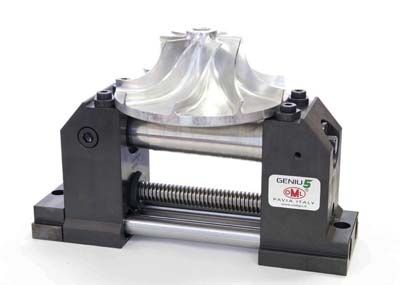
OML's new Genius 5-axis vice from Lexair Inc. reportedly turns workholding concepts on their head with a unique design that maximizes clamp force at the top of the jaws by pulling them closed at the top with a collapsing lead screw, while holding the bottom of the jaws in place with an opposing force screw. The dual-screw, pull-to-close Genius vice completely eliminates the tendency of traditional vice jaws to splay apart at the top, which requires machine operators to hammer a workpiece down against the stops as the jaws close and clamp force increases. By holding the vice jaws apart at the bottom and pulling closed at the top, the Genius vice actually pulls the workpiece down against the stops as closing force increases. The Genius vice is available in two sizes, capable of holding parts up to 8 inches, with maximum clamp force of 9,000 pounds.
The Genius vice is specifically designed for precision 5-axis milling with trunion-table machines. The adaptable vice easily secures oddly-shaped workpieces, such as turbine blades and blisks, and presents them to the spindle with minimal obstruction, reducing setups and ensuring repeatability of 0.0008".
Intended for production machining, the vice is built with precision, hardened and ground steel components. The jaws are guided on two heavy steel shafts, allowing quick, accurate centering on a pallet or machine table. A telescoping stainless steel cover fully encloses the collapsing lead screw to protect it from chips and coolant.
The Genius vice comes standard with one pair of positioning keys, grippers and wrench. A wide variety of stops, jaw plates, gripper inserts and other accessories are available. Custom opening sizes and other variations are available on request.
Contact Details
Related Glossary Terms
- centering
centering
1. Process of locating the center of a workpiece to be mounted on centers. 2. Process of mounting the workpiece concentric to the machine spindle. See centers.
- coolant
coolant
Fluid that reduces temperature buildup at the tool/workpiece interface during machining. Normally takes the form of a liquid such as soluble or chemical mixtures (semisynthetic, synthetic) but can be pressurized air or other gas. Because of water’s ability to absorb great quantities of heat, it is widely used as a coolant and vehicle for various cutting compounds, with the water-to-compound ratio varying with the machining task. See cutting fluid; semisynthetic cutting fluid; soluble-oil cutting fluid; synthetic cutting fluid.
- gang cutting ( milling)
gang cutting ( milling)
Machining with several cutters mounted on a single arbor, generally for simultaneous cutting.
- milling
milling
Machining operation in which metal or other material is removed by applying power to a rotating cutter. In vertical milling, the cutting tool is mounted vertically on the spindle. In horizontal milling, the cutting tool is mounted horizontally, either directly on the spindle or on an arbor. Horizontal milling is further broken down into conventional milling, where the cutter rotates opposite the direction of feed, or “up” into the workpiece; and climb milling, where the cutter rotates in the direction of feed, or “down” into the workpiece. Milling operations include plane or surface milling, endmilling, facemilling, angle milling, form milling and profiling.






